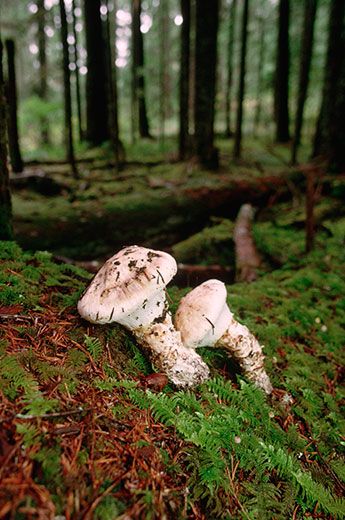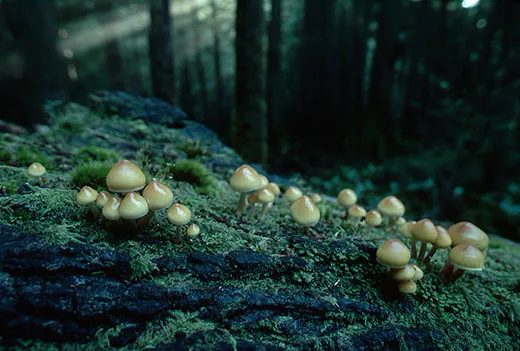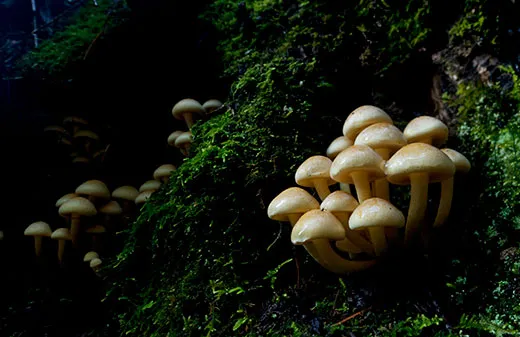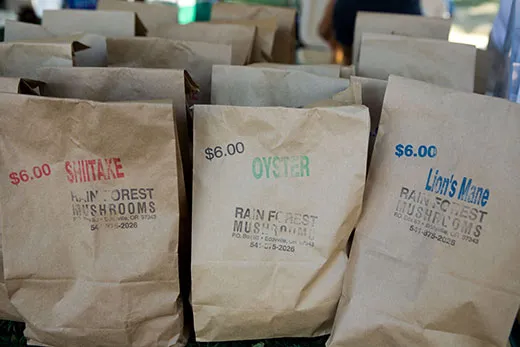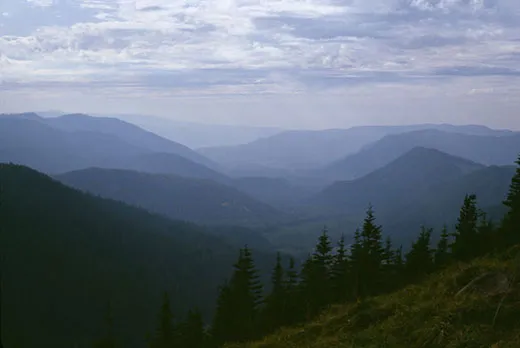The Surprisingly Exciting World of Mushroom Picking
In the forests of Oregon, foragers, farmers and chefs have their eyes stuck on the ground looking for one thing: wild mushrooms
/https://tf-cmsv2-smithsonianmag-media.s3.amazonaws.com/filer/mushroom-picking-oregon-631.jpg)
It’s ten minutes past 7 p.m. on a Friday in Eugene, and I’m squeezed into a folding chair in a crowded basement classroom at the University of Oregon, staring at a table covered with mushrooms. People are still pushing into the room, filling the chairs and settling themselves cross-legged on the floor. The air is thick with the smell of fungi. All around, I overhear snatches of conversation as old friends and new acquaintances swap lore and advice: “Forget hiking anymore,” one white-haired woman in a fleece jacket and boots tells the graduate student sitting near her. “You’ll always be looking down!”
We’ve all assembled to listen to Ed Fredette, a local self-proclaimed fungi enthusiast, talk about finding and identifying wild mushrooms. Fredette walks us through the basics of what he calls “mushroom chasing,” all the while repeating his tried and true mantra, “When in doubt, throw it out!” Even though only a few species of poisonous mushrooms have been identified in Eastern Oregon, people here are still worried about becoming sick from wild fungi. By the time he finally finishes answering questions, almost three hours have passed—this crowd is very, very, interested in mushrooms, and for good reason.
A marriage of local foods advocacy and recession-consciousness, mushroom foraging is especially hot stuff in rainy Oregon, where local ’shroomers picked literally tons of mushrooms last year, some earning hundreds of dollars for a day’s harvest. (Pickers also hunt for fungi in upper Michigan, Canada and New England.) From locovore chefs to DIY freegans, thousands of people scour the public forests and Cascade Mountains for mushrooms to sell at farmers’ markets and on Craigslist, or simply for their own identification or cooking. Fliers advertising baskets of matsutake or chanterelles fill the community bulletin boards at organic groceries across the state.
There are more than 5,000 types of fungi growing in the Pacific Northwest, where the heavy seasonal rains combine with conifer forests that stretch from the mountains down to the coastline, creating an ideal habit for some of the most popular edible species of mushrooms. Morels and the coveted matsutakes appear in the spring, and in the late summer and fall, the forests are filled with golden chanterelles, hen of the woods, and boletes. Winter brings hedgehogs and for those who know how to find them, valuable crops of truffles.
Fredette is just one of the many searching for fungi, and he exemplifies the grass-roots ethic that characterizes the pastime. “Don’t call me an expert,” he cautions. “I’m not a mycologist, but I’ve been doing this a long time, and I’m still alive and healthy.”
Dustin Olsen, the 31-year-old owner of The Mushroomery, in Lebanon, Ore., built his mushroom farm by hand when he decided to turn his hobby into a full-time business. Now he spends two days a week on his farm cultivating specimens, two days foraging and two days selling his harvest at farmers’ markets around the state as well as to restaurants, grocery stores and community-supported agriculture (CSA) customers. Olsen estimates that he earns about $25,000 to $30,000 a year simply from the wild mushrooms he gathers in the mountains.
“We’re in the right place in the right time,” Olsen says. “Just five years ago there were people who thought I was crazy, and now people are starting to come around and see the enormous value of mushrooms. They have vitamin D and amazing amounts of protein, and medicinal uses that haven’t really been studied until recently. More and more mushroom farms are popping up, and people are realizing that mushrooms have so many flavors; there are mushrooms that taste like maple syrup and ones that taste like lobster.”
“If you’re not excited by finding mushrooms, then you should take your pulse,” says Fred Shipley, the president of the Oregon Mycological Society, which educates people about mushrooms by holding monthly talks and sponsoring forays. The organization has about 900 members, but lest anyone mistake mushroom chasers as a homogenous bunch of environmental foodies, Shipley is quick to point out the diversity within Oregon’s larger mushroom scene, from the academic researchers at Oregon State University to the Asian and Latino transient pickers who follow the mushroom season up the Pacific Coast.
“There’s a class of people who only want to know where they can get the edibles, while others are more interested in identification or toxicology,” according to Shipley, while sustainability and localism seem to be drivers among the younger or more urban populations. But there are also rural foragers for whom mushrooms are a key food source and a Slavic community carrying on a cultural tradition, in addition to those with what Shipley calls, “romantic ideas about being outside.”
The farm-to-table ethos typified by Portland’s restaurant scene is flourishing across the state. It is particularly strong in the Willamette Valley, the heart of mushroom country, where the food and wine culture has grown substantially over the past few decades, and chefs increasingly emphasize ingredients found at their doorstep.
Christopher Czarnecki is executive chef of the Joel Palmer House, a Dayton, Ore., restaurant that specializes in wild mushrooms. Czarnecki, 32, says that almost all of the mushrooms used in his kitchens are gathered by his father, a retired chef, or by other family members and friends. Spreading the gospel of mushrooms drives much of his cooking. “Most chefs don’t really put enough emphasis on the unique flavor of all of the types of wild mushrooms,” he complains. “Too often, they’re used as a side notes.”
Stephanie Pearl Kimmel, the owner and founding chef of Marché, in Eugene, concurs. “It’s been a fabulous chanterelle season here, for example, which has been cause for celebration both in the kitchen and in the dining room,” she says. “Our chefs are able to purchase from a large number of foragers, our servers get to learn about the connections between season, climate, ecosystem—and then we share those connections with customers. The relationships between what’s on the plate, the people who put it there and the landscape that makes it possible are all stronger as a result.”
A recent meal at Marché drove home Kimmel’s words, as I savored an earthy terrine made from locally raised pork and garnished with Oregon white truffles that had nestled beneath a Douglas fir tree only days earlier.
Marché goes through about 40 pounds of wild mushrooms every week, and the Joel Palmer House serves even more. But for recreational pickers, it’s not as simple as wandering into the woods and scooping up mushrooms by the bushel. Most mushroom picking in Oregon takes place on public lands, overseen by the U.S. Forest Service or the Bureau of Land Management, and with that comes a complicated and often-contradictory tangle of regulations, permissions, and limitations. In some forests, both commercial and recreational pickers are required to purchase a permit, while other areas demand that pickers cut their mushrooms in half before leaving the forest in order to prevent selling. Varying restrictions are placed on the volume of mushrooms allowed, or the number of days a year a person may forage.
Many of the regulations in the Pacific Northwest are “just ridiculous,” says Leon Shernoff, editor of Mushroom: The Journal. “It’s certainly a legit concern that you don’t want people coming in and hauling off 50 tons of forage off of public lands, but at the same time I think they’ve gone very overboard in regulating the noncommercial people.”
Fungi may be big business in Oregon, but foraging is also a competitive, individual pursuit. The best spots are carefully guarded secrets; last October an experienced picker was found dead from hypothermia and exposure after losing her way while foraging alone in the Willamette National Forest. “Mushroomers are an inherent category of missing subjects because they don’t take much survival gear and they have their head down all of the time, so they tend to get disoriented out there,” said John Miller, the search and rescue coordinator at the Lane County Sheriff’s office. “I’ve had several pickers get lost more than once.” Miller says that the vast majority of missing people are found, but it’s not uncommon to see one or two fatalities every year. Statewide data shows that search and rescue missions for lost mushroom pickers rose significantly in the past year, from 18 missions in 2009 to at least 30 missions in 2010.
It was raining steadily on the Saturday morning that my husband and I set out on our own attempt at mushroom chasing, driving along the coastal mountain range to a spot friends had recommended in the Suislaw National Forest. Not taking any chances, we were prepared with warm jackets, boots, waterproof matches and GPS. We parked in a windy lot near the beach, hopped a highway barrier, crossed a swollen creek, and trudged through the brush up a steep incline to some trees. Under the tall conifers the undergrowth thinned, so that I found myself stepping into rich loam and among lichen-covered branches, rather than the brambles and bushes that had clustered closer to the shore.
We weren’t very hopeful—it was just our first forage, and at the very end of the season. But once our eyes adjusted to the dim light of the forest, we started seeing mushrooms everywhere, beneath our feet, under the gnarled roots of the trees, just up a slope, half-hidden by leaves. I suddenly understood what the woman at the lecture had meant about looking down. My eyes were glued to the ground, constantly seeking, and I had to remind myself to look up to orient myself, or to admire the sway of the trees towering over our heads. Given our inexperience, we had decided to limit any actual harvesting to two easily identifiable species, winter chanterelles and hedgehogs, but that didn’t stop us from exclaiming over the diversity of fungi that were blooming all around our boots. We unearthed delicate, violet-tinged mushrooms that were small and slick with dew; heavier, soapy-smelling stems with thick, gilled caps; and one twisted orange fungi that I guessed might be a late lobster, after consulting our pocket identification guide.
Despite the fact that the highway was less than a mile away, we felt utterly alone, and I quickly realized how easy it would be to get lost, especially if searching in a more isolated area. Mushroom foraging is all about taking the extra step, climbing over the fallen log, pressing on a little farther, peeking into one more hollow, just in case you might be missing a treasure. No wonder people wander off without realizing it. It was plain that other chasers had been here before us, given some of the more trampled patches of earth, and the occasional cluster of knifed stems that confronted us. After a couple of hours, we found ourselves at the edge of a low cliff, overlooking the Pacific Ocean. The sun was starting to set, and as we turned back to avoid the swift-falling dusk, we glimpsed a flash of yellow tucked below a damp tree—our first chanterelles.
